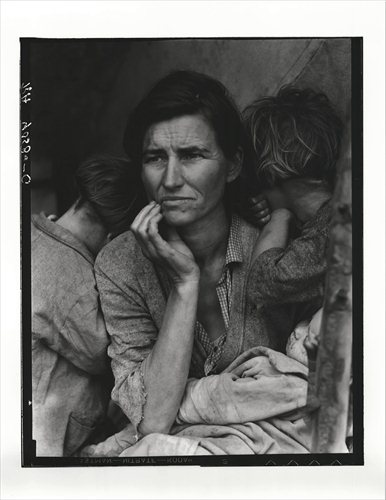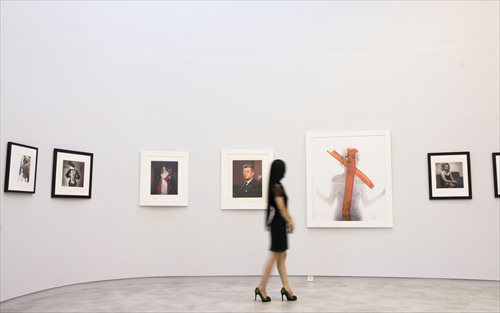Creating reality
Debut exhibition in Shanghai captures the evolution of photography
"Photography from the 20th Century: The Private Collection of Jin Hongwei," the very first exhibition at the new Shanghai Center of Photography, offers a broad overview of the development of one of the most rapidly evolving mediums in art history.
From the early days of glass-plate photography to contemporary explorations of digital photomontage, the exhibition follows a loosely chronological order, starting with works from early pioneers including Alfred Stieglitz (1864-1946) and Edward Steichen (1879-1973), who championed the camera's ability to create images rather than simply record reality.
It goes on to celebrate individuals like Harold Edgerton (1903-1990), an MIT scientist who developed mid-century technological innovations that made flash photography and frozen-motion imagery possible, and William Eggleston, born in 1939, whose 14 Pictures at MoMA in 1976 marked color photography's debut as museum displays.
Three favorites
Curator and collector Jin Hongwei worked as a photo editor at the Shanghai Pictorial magazine before studying at the Maryland Institute College of Art and settling in Atlanta. He began to collect works of 20th century photography in 2006, and currently owns more than 1,600 pieces.
Jin's extensive collection focuses primarily on three influential American photographers: Henry Callahan (1957-1982), Robert Mapplethorpe (1946-1989), and Sally Mann who was born in 1951. They are all well represented at the exhibition.
"Callahan's work is very simple; his images are primarily of flowers or leaves or people close to him, such as his wife and daughter," Jin said.
Mapplethorpe, on the other hand, produced works that critic Arthur Coleman Danto called "sufficiently erotic to be considered pornographic," but nevertheless "dionysiac and apollonian at once" in terms of their aesthetic presentation.
"Before 1980, not so many museums had a photography department. But because of Mapplethorpe's work, people began to consider photography as 'real' art and museums across America started opening photo departments. Before that it was only the Met or the MoMA," Jin said.

Migrant Mother by Dorothea Lange Photos: Courtesy of Shanghai Center of Photography

A visitor strolls through the exhibition.
But it is the black-and-white imagery by Mann that Jin deems the most powerful. Her controversial body of work is a record of the physical transformation from childhood to adulthood of the photographer's own children. The candid quality of the scenes Mann captured over the decades - examples at the exhibition include the naked torsos and limbs of her two young daughters sharing a bathtub, or chocolate cream running down a little girl's nude body, have resulted in accusations of pedophilia. Yet the photos possess a staged quality that belies the naturalness with which they were observed and captured.
Iconic photojournalism
Photojournalism and documentary photographs constitute a considerable part of the exhibit. Henri Cartier-Bresson (1908-2004), generally known as the godfather of photojournalism, witnessed the Spanish Civil War, WWII and India during the assassination of Gandhi through his lens.
On display is his iconic work taken in the Dessau concentration camp of WWII that encapsulates the seething rage of a people living under the Nazi regime. It exemplifies Cartier-Bresson's concept of "decisive moment," emphasizing the significance of clicking the shutter at one particular instant to perfectly exemplify the drama of the times.
Another high-profile photojournalist in the exhibit is Dorothea Lange (1895-1965), who is best-remembered for her documentation of poverty and oppression during the Depression Era in the US. The work on display, which was shot in a migrant camp, records a weathered, anxious mother who, according to the caption, survived on peas plucked from the fields and birds caught by her children. This single photograph was instrumental in prompting government aid to be sent to migrant communities languishing in the camps during those tragic years.
Nature and portraits
Not everything at the exhibit is tragic or controversial. Nature is prominently featured as well, such as the transcendental depictions of the American wilderness by the legendary master of scenery Ansel Adams (1902-1984), and Jerry N.Uelsmann's (born in 1934) more surrealist take on landscape, which employs a collection of motifs such as water and clouds combined with facial features.
It is interesting that, at first sight, Uelsmann's works look as if they have been Photoshoped. In fact, he used as many as 12 dark-room enlargers, each exposing a certain part of the print, before being lowered into the developer tray. In a long-gone time when the public still saw photographs as a faithful testament to reality, his bold collages managed to open up the viewer's mind.
Turning to the wide scope of portrait photography, a large-sized nude of Marilyn Monroe easily stands out. Bert Stern (1929-2013) was commissioned by Vogue magazine to shoot Monroe in 1962; the iconic starlet died six weeks later, making this series of photographs her last photo shoot. A prominent, scarlet-red "X" was drawn by Monroe herself onto the proof sheets, indicating her disapproval of their official publication.
Another world-famous last is also on display here, the 1980 Rolling Stone shoot with John Lennon lying naked next to a clothed Yoko Ono while tenderly kissing his wife's cheek. A mere five hours after Annie Leibovitz took this series, Lennon was shot outside of his apartment in New York. Lennon's "last kiss" is sadly beautiful.
Educational purpose
The part-gallery, part-museum style of the Shanghai Center of Photography, the latest art space to open in trendy West Bund, is Shanghai's first public venue dedicated solely to photography.
The center's director Rebecca Catching said she sees the exhibition as a good starting point for the new center, which utilizes technology to better educate patrons about the works on display. QR codes are posted next to each artwork, which allows digital scanners to access additional biographical information about the artist and work.
"We have done a lot of research for this show," Catching said.
"There will be lectures at the center, but at the same time you can download information to learn more about what you are seeing."
Date: Until July 22, 10:30 am to 5:30 pm
Venue: Shanghai Center of Photography
Address: 2555-1 Longteng Avenue
龙腾大道2555-1号
Admission: 20 yuan ($3.23)